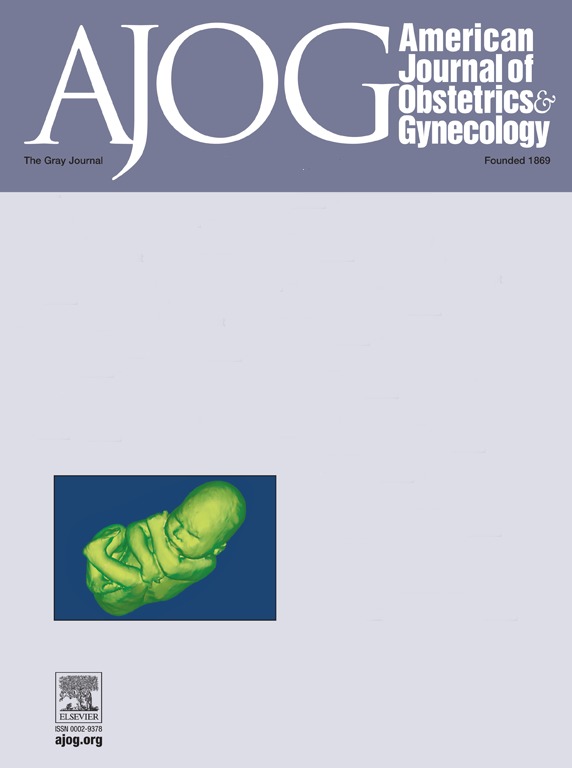Evaluating the impact of the second-stage and pushing duration on maternal and neonatal outcomes: A systematic review and meta-analysis.
IF 8.7
1区 医学
Q1 OBSTETRICS & GYNECOLOGY
引用次数: 0
Abstract
OBJECTIVES This systematic review and meta-analysis aimed to investigate the association between the duration of the second stage of labor-including both total duration and the active pushing-and adverse maternal and neonatal outcomes, stratified by parity. DATA SOURCES We conducted a comprehensive literature search of MEDLINE, Embase, and Cochrane databases from inception through October 2024. STUDY ELIGIBILITY CRITERIA Eligible studies reported maternal or neonatal outcomes related to second-stage duration or pushing duration, with data stratified by parity. Studies involving multiple gestations and those with prior cesarean deliveries were excluded. STUDY APPRAISAL AND SYNTHESIS METHODS Two independent reviewers performed data extraction and quality assessments; disagreements were resolved by a third reviewer. Cesarean delivery was prespecified as the primary maternal outcome, while other maternal and neonatal outcomes were analyzed as secondary outcomes. To quantify the association between prolonged second-stage or pushing duration (≥60 min) and each outcome, we performed post-hoc random-effects meta-analyses (Mantel-Haenszel) restricted to outcomes for which ≥2 eligible studies used <60 min as the reference category. Thus, only those studies meeting this criterion were pooled. RESULTS In total, 26 studies met the inclusion criteria: 18 retrospective cohort studies, 1 prospective cohort study, 6 secondary analyses of clinical trials, and 1 randomized controlled trial. Among nulliparous individuals, a second stage exceeding 1 hour was associated with increased risks of cesarean delivery, blood transfusion, perineal laceration, and chorioamnionitis; pushing beyond 1 hour was similarly associated with cesarean delivery and postpartum hemorrhage. Comparable trends were observed in multiparous individuals. Across both parity groups, neonatal intensive care unit (NICU) admission was more frequent when the second stage exceeded 1 hour. In nulliparous individuals, pushing beyond 60 minutes was significantly associated with a low 5-minute Apgar score and NICU admission. Only one study specifically evaluated pushing duration among multiparous individuals, finding no significant associations with neonatal morbidity. CONCLUSION Evidence indicates maternal and neonatal morbidity begins to rise within the first hour of the second stage and climbs with further prolongation, though the exact tipping point varies. Active pushing ≥60 min was associated with an increased risk of maternal morbidity, while neonatal effects are less certain; in nulliparas, we found an increased neonatal morbidity with pushing ≥60 min. Because the pooled estimates rely on a small, clinically heterogeneous subset of studies, these findings should be viewed with caution. Future studies should examine the individualized approach to determine the optimal timing of intervention, stratified by parity and epidural status, to refine duration guidelines.评估第二阶段和推动时间对孕产妇和新生儿结局的影响:一项系统回顾和荟萃分析。
目的:本系统综述和荟萃分析旨在调查分娩第二阶段持续时间(包括总持续时间和主动分娩时间)与产妇和新生儿不良结局之间的关系,并按胎次分层。数据来源我们对MEDLINE、Embase和Cochrane数据库进行了全面的文献检索,检索时间从建立到2024年10月。研究资格标准:符合条件的研究报告了与第二期持续时间或分娩持续时间相关的产妇或新生儿结局,数据按胎次分层。包括多胎妊娠和有剖宫产史的研究被排除在外。研究评价与综合方法:2名独立评审员进行数据提取和质量评估;分歧由第三位审稿人解决。剖宫产被预先指定为主要产妇结局,而其他产妇和新生儿结局被分析为次要结局。为了量化延长的第二阶段或推动时间(≥60分钟)与每个结果之间的关系,我们进行了事后随机效应荟萃分析(Mantel-Haenszel),仅限于≥2个符合条件的研究以<60分钟作为参考类别的结果。因此,只有符合这一标准的研究才被纳入。结果共纳入26项研究,其中回顾性队列研究18项,前瞻性队列研究1项,临床试验二次分析6项,随机对照试验1项。在未产个体中,第二阶段超过1小时与剖宫产、输血、会阴撕裂和绒毛膜羊膜炎的风险增加有关;分娩超过1小时同样与剖宫产和产后出血相关。在多产个体中也观察到类似的趋势。在两个胎次组中,当第二阶段超过1小时时,新生儿重症监护病房(NICU)入院的频率更高。在未分娩个体中,分娩超过60分钟与低5分钟Apgar评分和NICU入院显著相关。只有一项研究专门评估了多产个体的推压时间,发现与新生儿发病率没有显著关联。结论有证据表明,产妇和新生儿的发病率在第二阶段的第一个小时内开始上升,并随着时间的延长而上升,但确切的临界点有所不同。活动推压≥60分钟与孕产妇发病风险增加相关,而对新生儿的影响则不太确定;在新生儿中,我们发现推入≥60分钟会增加新生儿发病率。由于汇总估计依赖于一小部分临床异质性研究,因此应谨慎看待这些发现。未来的研究应该检查个体化的方法来确定最佳的干预时间,根据胎次和硬膜外状态分层,以完善持续时间指南。
本文章由计算机程序翻译,如有差异,请以英文原文为准。
求助全文
约1分钟内获得全文
求助全文
来源期刊
CiteScore
15.90
自引率
7.10%
发文量
2237
审稿时长
47 days
期刊介绍:
The American Journal of Obstetrics and Gynecology, known as "The Gray Journal," covers the entire spectrum of Obstetrics and Gynecology. It aims to publish original research (clinical and translational), reviews, opinions, video clips, podcasts, and interviews that contribute to understanding health and disease and have the potential to impact the practice of women's healthcare.
Focus Areas:
Diagnosis, Treatment, Prediction, and Prevention: The journal focuses on research related to the diagnosis, treatment, prediction, and prevention of obstetrical and gynecological disorders.
Biology of Reproduction: AJOG publishes work on the biology of reproduction, including studies on reproductive physiology and mechanisms of obstetrical and gynecological diseases.
Content Types:
Original Research: Clinical and translational research articles.
Reviews: Comprehensive reviews providing insights into various aspects of obstetrics and gynecology.
Opinions: Perspectives and opinions on important topics in the field.
Multimedia Content: Video clips, podcasts, and interviews.
Peer Review Process:
All submissions undergo a rigorous peer review process to ensure quality and relevance to the field of obstetrics and gynecology.

 求助内容:
求助内容: 应助结果提醒方式:
应助结果提醒方式:


